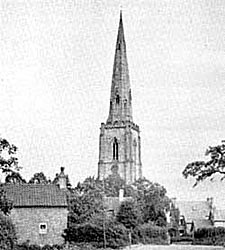< Previous | Contents | Next >
Gedling Church
 |
EVEN to-day in spite of the rapid spread of suburban conditions, Gedling retains something of its ancient village charm, and its church is a very beautiful feature of the landscape.
The main body of the church dates from the mid-thirteenth century, that is to say it was being built about the same time that Henry III., at the instigation of Simon de Montfort, summoned the meeting of the first English Parliament in 1264.
The details of the church are perhaps of greater interest to the specialist than to the casual wayfarer, but no one can fail to be attracted by the beauty of the lofty spire which seems to dominate the district. It dates from about 1320, so it may serve as a reminder to us of the disgraceful reign of Edward II., and the defeat at Bannockburn, and it was but newly finished when Edward Ill. arrested Roger Mortimer at Nottingham Castle in 1330.
A curious feature of the spire is the bulge which occurs half-way up. This is a well-marked example of a device called entasis by which an optical delusion was corrected. If the edges of the spire bad been built perfectly straight, the result would have been that it would have appeared to have a waist, and to counteract this delusion designers generally allowed for a slight swelling half-way up. This device was invented by the Greeks, who used it so freely that there is not a single straight edge in the Parthenan at Athens, all the seemingly straight lines are in reality slightly curved. Evidently the designers of Gedling Spire allowed too much entasis, but the result is both interesting and instructive.
But Gedling attracts other pilgrims than antiquaries, for in its churchyard lie two of our greatest cricketers. Arthur Shrewsbury, who died in 1903, was born at Lenton in 1856, and of him Dr. W. G. Grace said that he was the greatest batsman of his age. In 1887 he played eight three-figure innings, scored 1,653 runs and his average was 78. He was buried in Gedling churchyard, as also was Alfred Shaw, who died in 1907, and in his day was known as " The Emperor of Bowlers."
